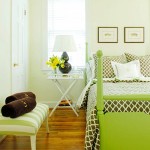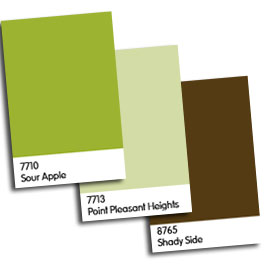
“Attentive Sheep” by enki22 is licensed under CC BY 2.0
Sometimes, the most difficult part of the painting process is picking the right colors. After all, nobody wants to spend money and time on a project only to end up with colors they don’t like all over their walls. For that matter, nobody wants to spend time and money on a project only to end up with colors that they “like” on their walls. We want to go through the work of that painting process and end up with results we love.
And so, many would-be home re-decorators find themselves bogged down in the very first step of the painting process: color selection. Because really, it’s all about color. If you put the right combination of colors together, the project turns out great. Use the wrong colors and it’s not going to matter whether or not you used the highest quality paints, the best brushes and roller covers made from the wool of spotless sheep raised in the pristine, picturesque landscapes of Norway (or wherever). All the fancy tools and quality paints in the world can’t save you from a bad color combo.
Color’s critical to every paint project and finding your inspiration isn’t always easy. As a result, many people start a project expecting to make big changes in their home. By the end of the project, however, they find that they’ve fallen back into old standards they’ve become comfortable with. They know those color schemes worked in their home and they know they’re safe. But we also all know that “safe” isn’t always fun.
Finding new colors, new combinations, exciting themes seems tricky, but it doesn’t need to be. In fact, the internet is filled with great color tools that will help you visualize color combinations you may never have thought of before. These tools are designed for various purposes, but all of them can be used by the savvy home re-decorator to narrow down her colors, and, most importantly, to help her step outside of her standard color schemes.
Benjamin Moore’s Color Chooser
The first online tool I want to recommend to you is the Benjamin Moore Color Chooser. This is a standard tool designed specifically for selecting paint color combinations.
When you click the link, you’ll be taken to a page where you can create your own projects, store colors and do all kinds of other tasks. But the main thrust of the site is to allow you to pick from a variety of sample room photos and then fill in the walls, the trim, the ceilings with the Benjamin Moore Colors of your choice. You’ll be able to see how the colors interact with each other and you’ll get an idea about what certain color combos might look like in your home.
Spin the Color Wheel
 Another great tool is called Spin the Color Wheel. And while it sounds like a game show, you’re not going to win any prizes here (except maybe a cool color scheme for your bathroom).
Another great tool is called Spin the Color Wheel. And while it sounds like a game show, you’re not going to win any prizes here (except maybe a cool color scheme for your bathroom).
Spin the Color Wheel is actually a tool that’s designed to help web-designers find perfect color schemes for, well, websites. And it’s actually kind of fun. (Even without the prizes. Or Pat Sajak. Or the crowd chanting “Spin. The. Wheel!”)
You just go to the site and click the “Spin the Color Wheel” button on the right. When you do so, you’ll be presented with 3 random color samples. If you don’t like any of them, you can “spin again”. If you like one or two of them, you can press a little “hold” button. This will lock this color down so it doesn’t change with subsequent spins of the wheel.
After going through it a couple times, I found 3 or 4 color schemes that I thought were pretty interesting (one of which is displayed in the picture above). Oh, they may need a little tweaking here and there, but still . . . I went from having no idea what colors to choose or what would look good together to having 3 or 4 places to start from.
The Color Wizard
 The Color Wizard is another web-designer tool. But, just like the Color Wheel one we just talked about, the Color Wizard can help you narrow down paint colors and discover new themes.
The Color Wizard is another web-designer tool. But, just like the Color Wheel one we just talked about, the Color Wizard can help you narrow down paint colors and discover new themes.
This one works based on some RED, GREEN and BLUE sliders. You just drag the sliders from left to right and your color samples change. Sounds pretty basic, right? Well, there’s an interesting twist to this site that makes it worth checking out: using a selection panel on the left of the color sample window, you can select different types of color schemes. You can select Complimentary Colors and the options you receive when you drag the sliders will represent complimentary colors on a color wheel. Or, you could select Analagous Colors and you’ll be presented with samples that are strictly analagous. It’s a great way to explore color, and, like the other tools I mentioned above, it’s a great way to jump start your creative mind and help you discover color schemes you may never have considered before.
All in All…
All in all, tools like these are great ways for nervous or newbie decorators to discover color schemes and open their eyes to the wide world of color. However, I’d recommend a couple cautions.
First, remember that the colors you see on your screen (especially when using the Benjamin Moore color chooser or any other paint-related color tool) are not necessarily accurate representations of the color in real life. Your monitor may show colors with a greener tint than they really have, or maybe a redder tone. In real life, when you see the chips you thought looked so good on the computer, you might find that they don’t look good at all.
But don’t despair! Use the color selection tools on the internet for a basis for color selection. If you saw a great tan, blue and green combination, but don’t like the color chips when you see them in real life, then find other chips that come close to the colors as you saw them on your monitor.
A second caution I’d urge is this: the web-designer tools are not going to present you with nice and tidy paint chip references. Instead, you’re going to get color names like “#FF7700” or the ever popular “#D1BEAD”. These are web colors and web-designers and other geeks know what they mean. If you go into a paint store with those numbers, you’re going to get a lot of blank stares. So, use those colors as starting points. Use them to figure out what colors you like to see together and then, when you go to the paint store, do your best to recreate what you found. Good luck, have fun . . . and most importantly, get painting!




 Pick up some simple shelves and splash them with a bright color and you’ll be amazed how much character they display. These simple, boring, run-of-the-mill shelves suddenly look like designer pieces when we see them in a pink or a bright yellow.
Pick up some simple shelves and splash them with a bright color and you’ll be amazed how much character they display. These simple, boring, run-of-the-mill shelves suddenly look like designer pieces when we see them in a pink or a bright yellow.


 For the last couple posts, I’ve been recounting sad and potentially awkward moments that served to illustrate my broader “paint point.” See, by telling you all about my pie making fiasco or my scooter-building screw up, I tried to convey the importance of following a recipe or a set of instructions.
For the last couple posts, I’ve been recounting sad and potentially awkward moments that served to illustrate my broader “paint point.” See, by telling you all about my pie making fiasco or my scooter-building screw up, I tried to convey the importance of following a recipe or a set of instructions.


 There are few places in your home where you can really cut loose and have a good time with color as much as you can in a kids’ room. When it’s your bathroom or your living room or a dining room we all tend to be a little more cautious. We don’t want to go nuts and create something on the walls that will drive us crazy or overpower our other decorating.
There are few places in your home where you can really cut loose and have a good time with color as much as you can in a kids’ room. When it’s your bathroom or your living room or a dining room we all tend to be a little more cautious. We don’t want to go nuts and create something on the walls that will drive us crazy or overpower our other decorating.